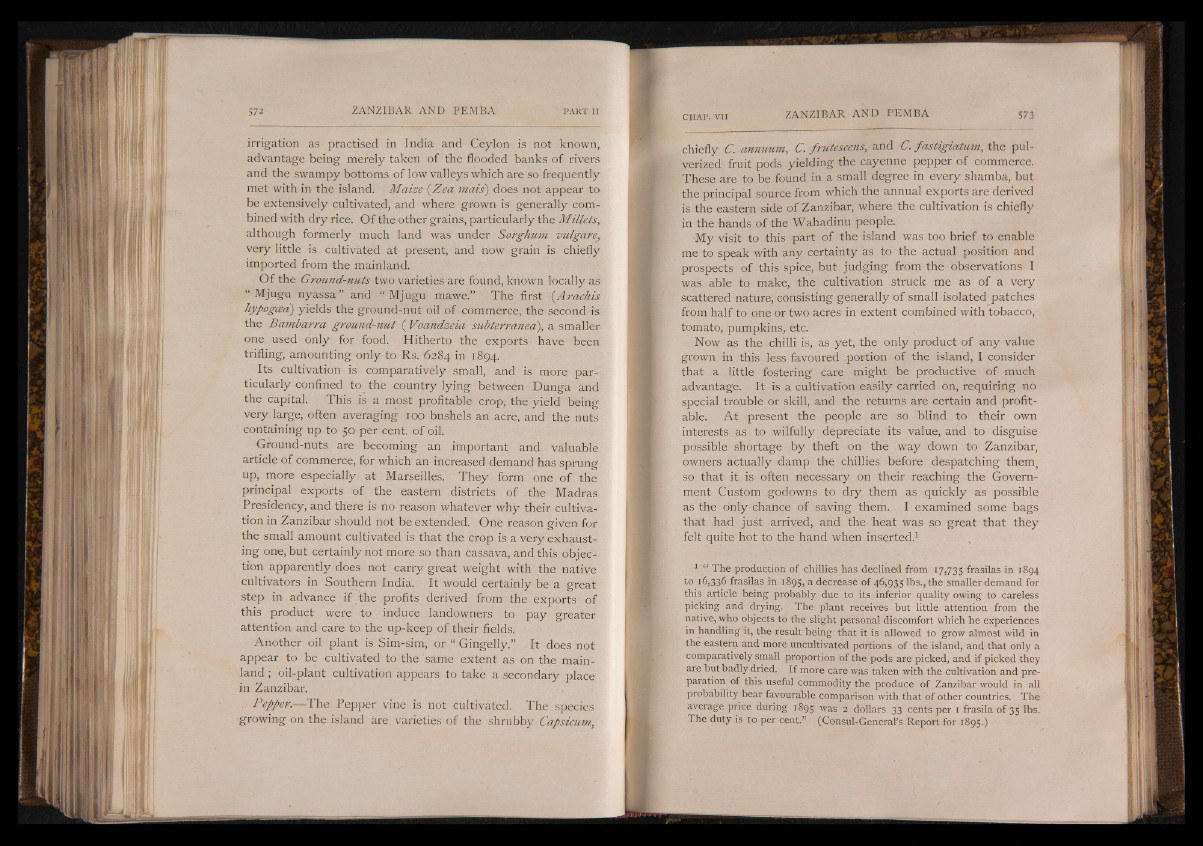
irrigation as practised in India and Ceylon is not known,
advantage being merely taken of the flooded banks of rivers
and the swampy bottoms of low valleys which are so frequently
met with in the island. Maize (Zea mais) does not appear to
be extensively cultivated, and where grown is generally combined
with dry rice. Of the other grains, particularly the Millets,
although formerly much land was under Sorghum vulgare,
very little is cultivated at present, and now grain is chiefly
imported from the mainland.
O f the Ground-nuts two varieties are found, known locally as
“ Mjugu nyassa” and “ Mjugu mawe.” The first (A rack is
hypogaa) yields the ground-nut oil of commerce, the second is
the Bambarra ground-nut ( Voandzeia subterranea), a smaller
one used only for food. Hitherto the exports have been
trifling, amounting only to Rs. 6284 in 1894.
Its cultivation is comparatively small, and is more particularly
confined to the country lying between Dunga and
the capital. This is a most profitable crop, the yield being
very large, often averaging 100 bushels an acre, and the nuts
containing up to 50 per cent, of oil.
Ground-nuts are becoming an important and valuable
article of commerce, for which an increased demand has sprung
up, more especially at Marseilles. They form one of the
principal exports of the eastern districts of the Madras
Presidency, and there is no reason whatever why their cultivation
in Zanzibar should not be extended. One reason given for
the small amount cultivated is that the crop is a very exhausting
one, but certainly not more so than cassava, and this objection
apparently does not carry great weight with the native
cultivators in Southern India. It would certainly be a great
step in advance if the profits derived from the exports of
this product were to induce landowners to pay greater
attention and care to the up-keep of their fields.
Another oil plant is Sim-sim, or “ Gingelly.” It does not
appear to be cultivated to the same extent as on the mainland
; oil-plant cultivation appears to take a secondary place
in Zanzibar.
. Pepper.— The Pepper vine is not cultivated. The. species
growing on the island are varieties of the shrubby Capsicum,
chiefly C. annuum, C. frutescens, and C. fastigiatum, the pulverized
fruit pods yielding the cayenne pepper of commerce.
These are to be found in a small degree in every shamba, but
the principal source from which the annual exports are derived
is the eastern side of Zanzibar, where the cultivation is chiefly
in the hands of the Wahadinu people.
My visit to this part of the island was too brief to enable
me to speak with any certainty as to the actual position and
prospects of this spice, but judging from the observations I
was able to make, the cultivation struck me as of a very
scattered nature, consisting generally of small isolated patches
from half to one or two acres in extent combined with tobacco,
tomato, pumpkins, etc.
Now as the chilli is, as yet, the only product of any value
grown in this less favoured portion of the island, I consider
that a little fostering' care might be productive of much
advantage. It is a cultivation easily carried on, requiring no
special trouble or skill, and the returns are certain and profitable.
At present the people are so blind to their own
interests as to wilfully depreciate its value, and to disguise
possible shortage by theft on the way down to Zanzibar,
owners actually damp the chillies before despatching thenv
so that it is often necessary on their reaching the Government
Custom godowns to dry them as quickly as possible
as the only chance of saving them. I examined some bags
that had just arrived, and the heat was so great that they
felt quite hot to the hand when inserted.1
1 “ The production of chillies has declined from 17,735 frasilas in 1894
to !6,336 frasilas in 1895, a decrease of 46,935 lbs., the smaller demand for
this article being probably due to its inferior quality owing to careless
picking and drying. The plant receives but little attention from the
native, who objects to the slight personal discomfort which he experiences
in handling'it, the result being that it is allowed to grow almost wild in
the eastern and more uncultivated portions of the island, and that only a
comparatively small proportion of the pods are picked, and if picked they
are but badly dried. If more care was taken with the cultivation and preparation
of this useful commodity the produce of Zanzibar would in all
probability bear favourable comparison with that of other countries. The
average price during 1895 was 2 dollars 33 cents per 1 frasila of 35 lbs.
The duty is 10 per cent.” (Consul-General’s Report for 1895.)